#Growing vegetables in containers
Explore tagged Tumblr posts
Text
✅✅Growing vegetables in containers is a great way to enjoy fresh produce, even if space is limited. Here are some of the best vegetables to grow in containers:

Tomatoes: ✅✅Varieties: Cherry or bush types (e.g., 'Patio Princess' or 'Tiny Tim') do well in containers. Container size: 5-gallon pot or larger.
Tips**: Stake or cage for support and provide plenty of sunlight and regular watering.
Peppers: ✅✅Varieties: Both sweet and hot peppers thrive in containers. Container size: 3 to 5-gallon pots. Tips**: Full sun and well-draining soil are key.
Lettuce: ✅✅Varieties: Leaf lettuce like 'Black-Seeded Simpson' or 'Salad Bowl' are ideal. Container size: Shallow containers (6-8 inches deep). Tips: Grows quickly and prefers cooler weather, so partial shade can help.
Spinach: ✅✅Varieties: Most types work well, but 'Baby Leaf' is particularly suited to containers. Container size: 6 inches deep or more. Tips**: Grow in cooler weather with regular watering.
Radishes: ✅✅Varieties: Quick-growing varieties like 'Cherry Belle' are perfect. Container size: Shallow pots (6 inches deep). Tips**: Ideal for small spaces and quick harvests in cooler weather.
Carrots: ✅✅Varieties: Choose short or round varieties like 'Thumbelina' or 'Nantes'. Container size: 12 inches deep or more. Tips**: Ensure loose soil for root growth and keep soil consistently moist.
Cucumbers: ✅✅Varieties: Bush or dwarf varieties (e.g., 'Spacemaster'). Container size: 5-gallon pots. Tips**: Provide support for vining types and ensure full sun.
Green Beans: ✅✅Varieties: Bush beans (e.g., 'Bush Blue Lake' or 'Contender') are best for containers. Container size: 12 inches deep or more. Tips**: They don’t require much space and can produce a large harvest in a small area.
Eggplants: ✅✅Varieties: Compact varieties like 'Patio Baby' do well in containers. Container size: 5-gallon pots or larger. Tips**: Needs full sun and regular watering.
Herbs (Bonus) ✅✅Varieties: Basil, parsley, cilantro, thyme, and rosemary thrive in containers.
✅✅Container size: Small pots (6-8 inches deep). Tips**: Grow in a sunny spot and harvest regularly to encourage new growth.
✅✅General Tips: Soil**: Use a high-quality potting mix, not garden soil, for proper drainage.
✅✅Watering: Containers dry out faster, so water regularly and ensure proper drainage.
✅✅Sunlight: Most vegetables need 6-8 hours of direct sunlight each day.
✅✅Ertilizing: Since nutrients can wash out of containers, use a balanced fertilizer to support growth.
New Apparel has Arrived in Stock Get it now from here🛒🛍️👕👇🇺🇸
#Container vegetables#Small space gardening#Best vegetables for pots#Urban gardening tips#Growing vegetables in containers#gardening#gardeningloverfamily#gardeninghour#plantblr#nature#cottagegarden#gardeningtshirt#grading#flowers#plants
4 notes
·
View notes
Text

7/13/24 ~ harvest 🧺
#harvest meal#food harvest#edible gardening#gardening 101#organic garden#indoor garden#sustainable gardening#container gardening#vegetable gardening#starting seeds#growing food#plant life#plant mom#homesteading#jing orange okra#wild boar farms#wild run garden
29 notes
·
View notes
Text

🍓🌱 Excited about growing your own organic strawberries right at home? 🌱🍓
Did you know you can grow delicious, pesticide-free strawberries even if you have limited space? 🍓🌿 Container gardening is the perfect solution! 🌞🏡
👩🌾👨🌾 Whether you're a seasoned gardener or just starting out, here are some tips for growing juicy strawberries in containers:
1️⃣ Choose a sunny spot: Strawberries love sunlight! Place your containers where they'll get at least 6-8 hours of direct sunlight daily.
2️⃣ Pick the right container: Opt for large containers with drainage holes to prevent waterlogging. Terra cotta or plastic pots work well.
3️⃣ Use quality soil: A well-draining, nutrient-rich soil mix (like compost and peat moss) is ideal for strawberries.
4️⃣ Planting time: Spring is perfect for planting strawberries. Space your plants about 8-12 inches apart to allow room for growth.
5️⃣ Watering and feeding: Keep the soil consistently moist, but not waterlogged. Feed your strawberries with organic fertilizer every 2-3 weeks.
6️⃣ Pest control: Keep an eye out for pests like slugs and birds. Netting can protect your berries while still allowing sunlight in.
➡️ Want to read my full article: How to Grow Organic Strawberries in Containers!
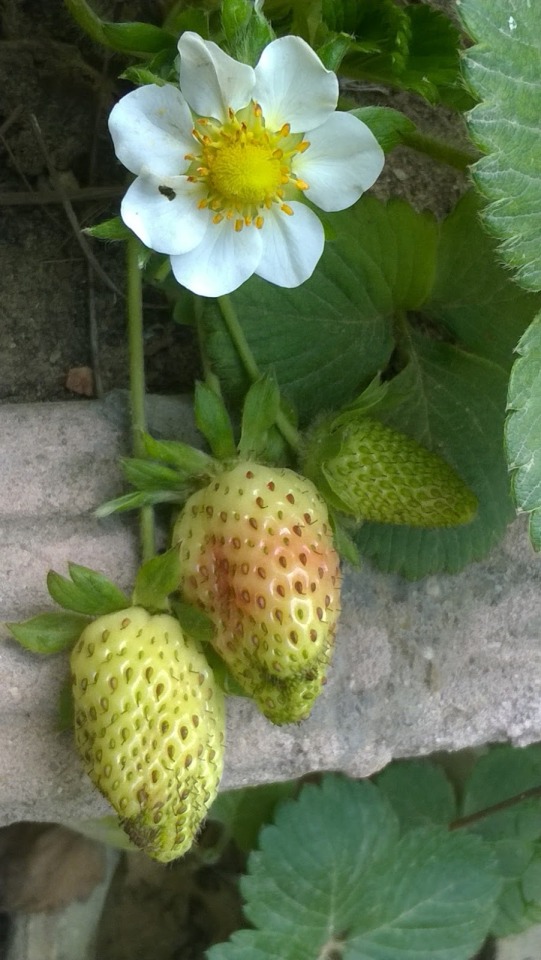
🎉 Growing your own strawberries is not only rewarding, but also a delicious way to enjoy fresh, organic fruit all summer long! Have you tried growing strawberries in containers? Share your tips and experiences below! 🍓💬
#gardening#garden#lovegardening#gardening tips#gyo#gardening uk#gardenchat#organic gardening#vegetable gardening#backyard#strawberry#strawberries#fruit#grower#growth#grow your own#grow your own food#gardens#gardenblr#gardencore#gardeners on tumblr#home and garden#my garden#potted garden#urban gardening#vegetable garden#plants#containergardening#container#container gardening
12 notes
·
View notes
Text


June garden update
Omg, so many things have changed since May, but I try to do my best to summarize:
- Planted tomatoes, paprikas, eggplants and cucubers. They are looking pretty good now!
- Created a raised bed, I used the hugelkultur method
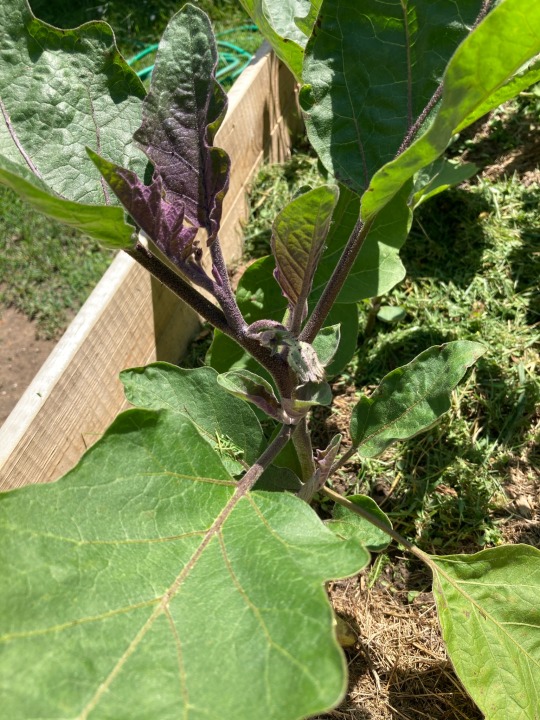
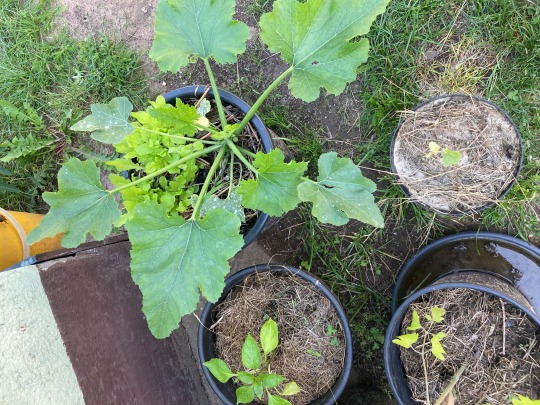
- Lettuce, tomatoes, zucchinis, and sunflowers are getting HUGE
- Ruccola is not growing very well, I might have to find a less sunny spot for them
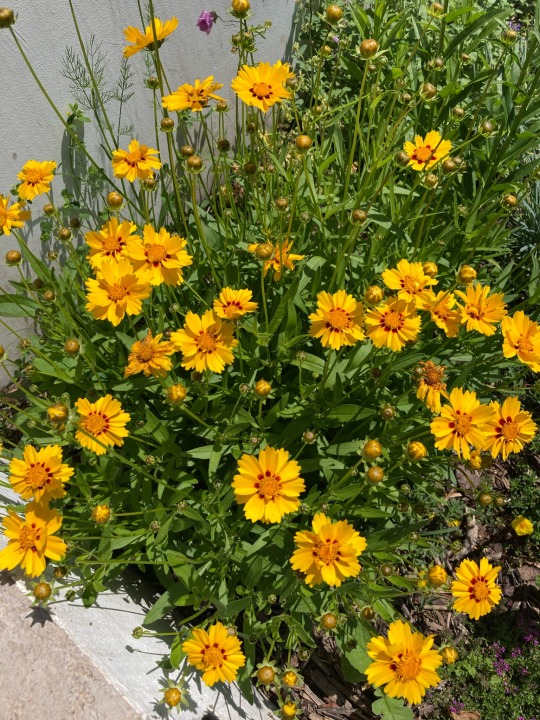
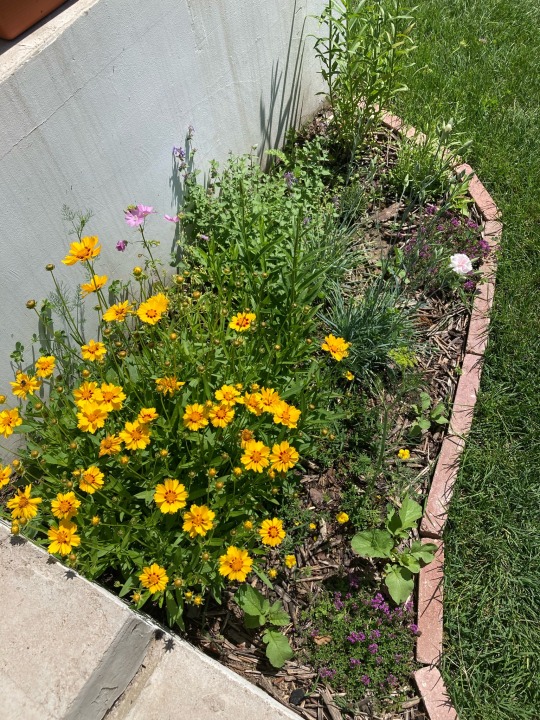
- Coreopsis just started blooming
- I got hooked on growing microgreens, I will post a separate little article about it later

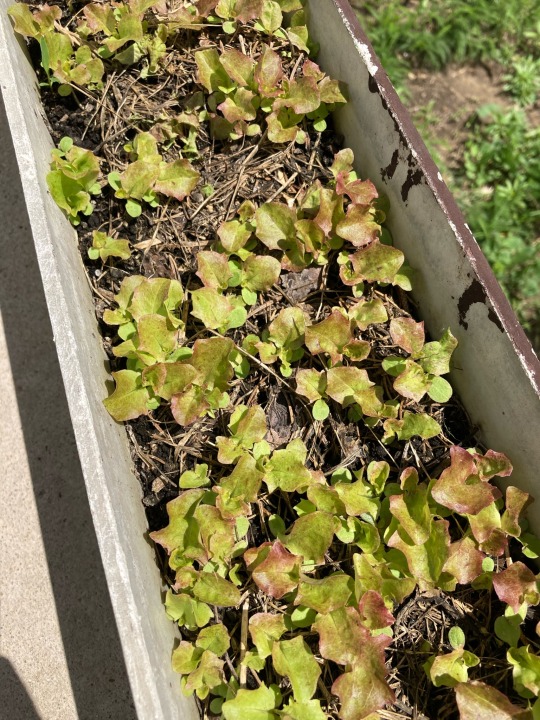
#solarpunk#gardening#garden#sustainability#permaculture#garden update#vegetables#container gardening#growing food#balconygarden#raised beds#self sufficiency
73 notes
·
View notes
Text
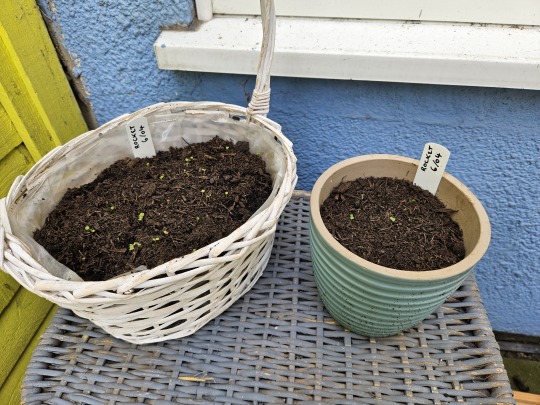
It's only been 5 days and the rocket is already peeping!
#adventures in gardening#solar punk#solarpunk#diy punk#Grow it yourself#container gardening#vegetable gardening#urban gardening#image description in alt
14 notes
·
View notes
Text

Me anytime the weather is 50 or better mid-winter ;)
#urban gardening#gardeners of tumblr#gardeners on tumblr#gardening#fruits#container gardening#grow your food#grow your own food#vegetables#food security#seedlings#spring garden#summer garden#happy tuesday
7 notes
·
View notes
Text
I harvested the garlic today! 91 bulbs, so only 9 failed or died early. bunched and hung up in the garage to cure (eye hooks and rubberbands).

I used 5 gallon containers filled with compost, planted one clove for each gallon of soil, fertilized with organic 3-3-3 and mycorrhizae, then did nothing else for 7 months. no watering, no extra fertilizer, nothing. California Softneck. Here's the link to my first garlic update, with the video that inspired me to plant in containers this year.

Typically a mid-october planting would be ready in june or july but it's been a hot winter/spring. Our last frost date is usually the second week of april, but this year it was mid-february. 90 degree temps in march and april probably helped these guys get done too early. As a result, I failed to realize when they were ready to harvest a few weeks ago (a recurring problem with me) so they may have fewer layers of skin than I would like, but it shouldn't be a problem.
last year I also waited too late to harvest, but like, WAY too late, so a lot of bulbs were left with exposed cloves, but that didn't happen this time. only 3 bulbs were so small that I didn't bother harvesting, everything else is medium/small sized. a few honkers for sure but nothing special.
even though I have yet to perfect it, garlic is one of my favorite things to plant because they're literally the easiest thing to plant, are used in basically every recipe, and the unique leaves are beautiful in early spring.
#time to grow#gardenblr#organic gardening#plantblr#my garden#raised garden beds#container gardening#garlic#vegetables
5 notes
·
View notes
Text
A Beginner's Guide to Growing Herbs Indoors: Tips for Thriving Indoor Herb Gardens
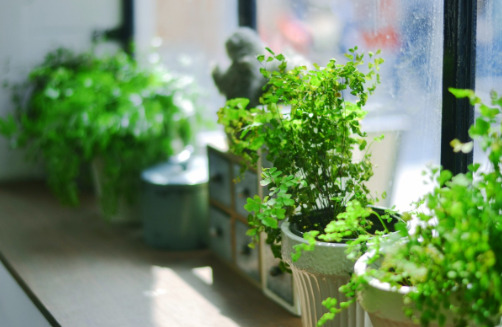
For those who have never grown herbs before, cultivating them indoors can be a delightful and fragrant experience. Growing an indoor herb garden is a wonderful and doable hobby, regardless of your interest in cooking or just the convenience of having fresh herbs on hand. This in-depth guide will show you how to successfully grow your very own indoor herb garden..
Choosing the Right Herbs: Start by selecting herbs that are well-suited for indoor cultivation. Popular choices include basil, mint, rosemary, thyme, and parsley. Choose herbs that share similar growing requirements to simplify maintenance.
Selecting the Right Containers: Choosing the right containers is crucial for successful indoor herb gardening. Ensure that your pots have adequate drainage holes to prevent waterlogging. Additionally, consider the size of the pots, allowing ample space for root growth.
The Perfect Potting Mix: Herbs thrive in well-draining soil. Create a suitable potting mix by combining regular potting soil with perlite or coarse sand to enhance drainage. This ensures that your herbs receive the right balance of water and air.
Providing Adequate Light: Indoor herbs require plenty of sunlight to thrive. Place your herb garden near a south-facing window where they can receive at least 6-8 hours of sunlight daily. If natural light is scarce, consider supplementing with fluorescent grow lights.
Watering Wisely: Overwatering is a common mistake in herb gardening. Allow the topsoil to dry out slightly before watering. When watering, do so thoroughly, ensuring the water reaches the roots. Always use a saucer under the pots to catch excess water and prevent water damage.
Temperature and Humidity: Most herbs prefer temperatures between 60-70°F (15-21°C). Ensure the indoor environment remains well-ventilated, as stagnant air can lead to problems like mold. Humidity levels between 40-60% are generally suitable for herb cultivation.
Fertilizing Routine: Herbs benefit from periodic feeding during the growing season. Use a balanced, water-soluble fertilizer every 4-6 weeks. Be cautious not to over-fertilize, as this can harm the plants.
Pruning and Harvesting: Regular pruning encourages bushier growth and prevents herbs from becoming leggy, or similarly, elongated or stretched. Harvest leaves in the morning when the essential oils are most concentrated. Avoid removing more than one-third of the plant at a time to ensure continued growth.
Dealing with Common Pests: Keep an eye out for common pests like aphids and spider mites. A mild solution of water and dish soap can help control these pests. Alternatively, introduce beneficial insects like ladybugs to keep your indoor garden pest-free.
In closing, embarking on the journey of growing herbs indoors is a delightful adventure for beginners. By choosing the right herbs, containers, soil, and providing the optimal growing conditions, you'll soon be enjoying the bountiful harvest of your indoor herb garden. Follow these tips, stay patient, and watch as your herbs flourish, bringing a touch of freshness to your culinary endeavors. Happy herb gardening!
#botany#garden#gardening#horticulture#how to#life hacks#planting#plants#tips and tricks#Indoor Herb Garden#Culinary Herbs#growing herbs#home gardening#container gardening#gardening tips#seeds#vegetable gardening#urban gardening#Beginner Gardening#organic herbs#Sustainable Gardening#Kitchen Herb Garden#Herb Planting#herbalism#Herb Care#Gardening Tips#indoor plants#house plants#potted plants#DIY Herb Garden
3 notes
·
View notes
Text
Victory Garden Planning - January 2024

View On WordPress
#container gardening#flowers#food#fruit of your hands#fruits#garden#garden layout#garden plans#grow#harvest#herbs#homemade#organic#planner#produce#raised beds#top post#vegetable#victory garden#work with your hands
3 notes
·
View notes
Text
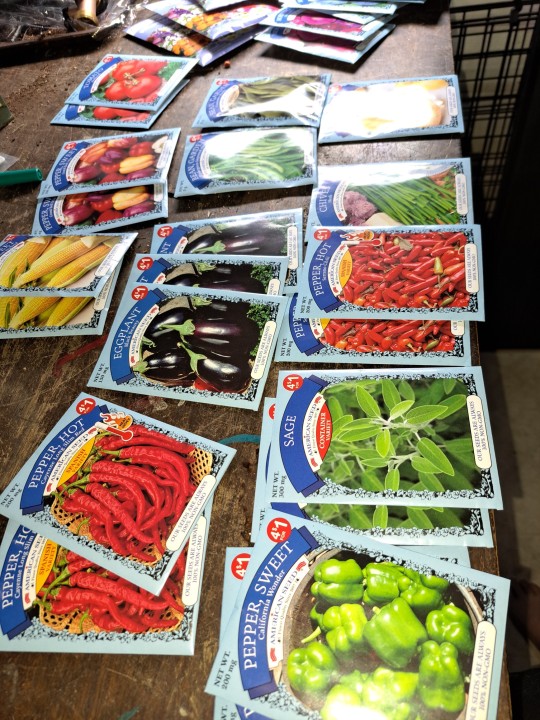
Spent 14$ at the dollar store and got all these seeds. Idk who needs to hear this, but dollarstore seeds grow almost better than the more pricey brands.
#urban gardening#budget#budget gardening#container gardening#urban farming#green thumb#self sustainability#growing stuff#gardenblr#seratonin#gardeners on tumblr#gardencore#dollar store#diy#fresh vegetables#peppers out the ass
10 notes
·
View notes
Text
Budding Green Thumbs: A Beginner's Guide to Best Plants for Home Garden
Home gardening is certainly an interesting adventure even more so for the “green-thumb” beginner. A good starting point could be plants that are readily pardoned, easy to cultivate and produce good results. This guide shall discuss some of the best plants for the novice grower who finds pleasure in growing. 1. Herbs: Beginning with herbs is a good way to introduce home-gardening as they offer…

View On WordPress
#Best plants for balcony gardening#Choosing plants for limited space gardening#Container gardening tips for beginners#Easy-to-grow herbs for beginners#Low-maintenance plants for beginners#Quick-growing vegetables for beginners
2 notes
·
View notes
Text
maybe it’s bc i was raised veggie but i don’t understand why an argument against being raised veggie is that your body can’t process meat when you’re older like…… i don’t ever want to eat meat. that is not a problem for me or my sisters. it’s such a strange argument bc imo if you’re raised veggie you aren’t likely to be eating meat later in life anyway???
#and obviously there is an argument about choice#but my parents always said that i could eat meat if i wanted to!! i just Didn’t!! it has never appealed to me#and yes vegetarianism from birth can cause deficiencies & maybe some people would have to start eating meat bc of that#but there are soooo many more veggie options than there were when i was growing up#and lest we forget vegetables exist. that contain nutrients. and there are vitamins you can take. meat isn’t the Only Source of nutrients#anyway enough vegetarian ranting for tonight#godbless spinach. and lentils. and butter beans. and broccoli. yumbyyyy
1 note
·
View note
Text

6/27/24 ~ lil baby harvest 🍅🌶️🍓
#growing strawberries#chinese five color#serrano pepper#indoor garden#sustainable gardening#container gardening#vegetable gardening#starting seeds#growing food#plant life#homesteading#food harvest#harvest season#june 2024#garden 2024#2024 garden
28 notes
·
View notes
Video
youtube
Planting Eggplant and Basil in a Terra-Cotta Container: Tips for Success
🌱🍆 Dive into the luscious world of homegrown delights with our in-depth tutorial on planting eggplant seedlings and basil in terra-cotta containers! 🌿🌞 Experience the sheer satisfaction of nurturing your own garden-to-table ingredients as we guide you through every step of the process. From selecting the perfect terra-cotta pot to gently tucking each seedling into its cozy new home, you'll learn the art of creating a harmonious oasis of flavor right on your balcony or patio. 🏡💫 Let the earthy scent of rich potting soil and the promise of bountiful harvests ignite your passion for urban gardening. Join us on this flavorful journey and elevate your culinary creations to new heights of freshness and taste!
#youtube#youtube video#youtube views#video#videos#eggplant#basil#container gardening#containergarden#gardening tips#gardening uk#urban gardening#vegetable gardening#vegetables#growing vegetables#gardening
3 notes
·
View notes
Text

Super cute winter veggie install, lots of lettuces and kale for the coming cooler temperatures. Also added broccoli and cauliflower to the main raised beds.
🥬🥦🧄
#gardening#landscaping#plants#work#philly#vegetables#container gardening#freelance gardener#growing food#fall
0 notes
Text
How to begin a sustainable way of life
This is a draft of something I've been writing for a couple months. It is mainly focused on the culture of the USA. Feel free to repost or otherwise share, with or without credit.
Do not tell people what to do—help them do it!
Give the gift of relief from being forced to engage in society’s unsustainable ways of life.
“People need to eat more plant-based foods.” ->Talk about your favorite recipes, give others recipes, cook for them, and grow vegetables and plants in your garden and give them away as gifts.
“People need to repair their clothes.” -> Offer to repair others’ clothes, and teach people how to repair their clothes.
“People need to buy less clothes.” -> Give them old clothes that you don’t want, help them repair their clothes
“People need to buy less plastic stuff.” -> Learn to make things that can serve the same purpose, such as baskets, and give them as gifts. Let people borrow things you own so they don’t have to buy their own.
“People need to stop using leafblowers and other gas-guzzling machinery.” -> Offer to rake the leaves. You can use them as compost in your own garden.
“People need to be more educated about nature.”-> Learn about nature yourself. Tell people about nature. Be open about your love of creatures such as snakes, spiders, and frogs. Do not show awareness that this could be strange. You are not obligated to quiet down your enthusiasm for creepy crawlies to demonstrate awareness that it is weird. Point out at every opportunity how these animals are beneficial.
“People need to use cars less.” -> Offer rides to others whenever you must go somewhere. Whenever you are about to go to the store, ask your neighbor or your friend who lives along the way, “Is there anything you need from the store?”
You cannot control others’ behaviors, but you can free them from being controlled.
If you think to yourself, “But this would be so difficult to do!” ask yourself WHY? Why does your society coerce you into less sustainable ways of living, forcing you to consume excessively? After thinking about this, consider that it is less simple and easy than you thought to make more sustainable choices, so why would you judge others for not doing it?
Do not act alone—act with others!
Environmentally friendly behaviors that can be done alone, without collaborating with or consulting another person, are the least powerful of all. Whenever an “environmentally friendly” behavior is suggested, figure out “How can I give this as a gift?” or “How can I make this possible on the level of a whole community?”
“Personal choices” do not work because every single person has to make them individually. If you are focused on making your own personal choice, you are not focused on others. If you are not focused on others, you are not helping them. If nobody is helping each other, most people won’t be able to make the “personal choice.”
You inherently share an ecosystem with your neighbors
Start with your neighbors, the people physically close to you. You live on the same patch of land, containing roots from the same plants and trees. You can speak to them face to face without traveling, which means you can easily bring them physical things without using resources to travel.
Always talk to your neighbors and be friendly with them. Offer them favors unprompted and tell them about how your garden is doing. Do not be afraid to be annoying—a slightly annoying neighbor who is helpful, kind, and can be relied upon for a variety of favors or in times of need is a necessary and inevitable part of a good community. If you make the effort to be present in somebody’s life, they will have to put up with you on some occasions, but that is just life. We cannot rely on each other if we do not put up with each other.
Simply spending time with someone influences them for good
Every hour you spend outside with your neighbor is an hour your neighbor doesn’t spend watching Fox News. Every hour you spend talking with someone and interacting with them in the real world, eating real food and enjoying your real surroundings, is an hour you don’t spend only hearing a curated picture of what reality is like from social media.
Isolation makes it easy for people to become indoctrinated into extremist beliefs. When someone spends more time alone, watching TV, Youtube, or scrolling social media, than they do with others, their concept of what other people are like and what the world is like comes more from social media than real life. TV and online media are meant to influence you in a specific way. Simply restricting the access these influences have to yourself and others is helpful.
A garden is the source of many gifts
If you grow a garden, you can give your neighbors and friends the gift of food, plants, and crafted objects. This is one of the foundational ways to form community. When you give food, you provide support to others. When you give plants, you are encouraging and teaching about gardening. It is even better when you give recipes cooked from things you grew, or items crafted from things you grew. You can also give the gift of knowledge of how to grow these plants, cook these recipes, or craft these objects.
More on gift-giving
Some people are uncomfortable with receiving items or services as gifts. They want to feel like they are giving something back, instead of having obligation to return the favor hanging over them.
It can help to ask a simple favor that can be easily fulfilled. People generally like the feeling of helping someone else.
When you give someone a gift, it can help to say something like “Oh, I have too many of this thing to take care of/store/eat myself! Do you think you could take some?” This makes your neighbor feel like they are helping you.
When allowing others to borrow items, you might not get them back. Don’t worry about that. It just means the item found a place where it was needed the most. You can ask about the item if you think it might have been forgotten, and this can create an opportunity for a second meeting. But don’t press.
If the person you give to insists upon some form of payment, this is a good opportunity to negotiate a trade.
Ask to be given compostable or recyclable things
Ask your neighbor to save compostable scraps, biodegradable cardboard and paper products, and any other items that might be put to use. Use them in your own compost pile. Or, start a compost pile at the edge of the yard where you both can add to it. Remember that “wet” compost like vegetable and fruit bits needs to be mixed with twice as much of “dry” and “woody” compost like cardboard, leaves, small twigs, paper and wood bits.
Use the front yard for gardening
Overcome the cultural norm that the front yard is only decorative. Use the front yard for gardening so you can be seen by others enjoying your garden, and others can witness the demonstration of the possibilities of land. In the front yard, anything you do intentionally with your land can be witnessed. It also makes you a visible presence in your community.
Grow staple foods
Don’t just grow vegetables that cannot be the core component of a meal themselves. Grow potatoes, dry beans, black eyed peas and other nourishing, calorie-dense foods. Grow the ingredients of meals. You could even build a garden around a recipe.
Invite neighbors and friends over to eat food made from things you grew
Be sure to send them home with leftovers.
Grow plants for baskets
Containers are one of the fundamental human needs. If we had more containers, we wouldn’t need plastic so much. You can learn to make baskets, and to grow plants that provide the raw materials for baskets.
If someone rakes their leaves, ask to have the leaves
If you see someone putting leaves in bags, don’t be afraid to ask if you can have the leaves. More likely than not they will be happy to agree.
Collaborate with neighbors to plant things in the no-man’s-land of the property line
In the border land between your neighbor’s yard and your yard, it is almost always just mowed grass because no one can plant anything without it affecting their neighbor. But these border lands add up to a lot of space. It would be much better if you talked to your neighbor about what would be nice to plant there, and together created a plan for that space.
Give others the freedom to wander
Make it clear that you will not get mad if the neighbor’s kids play in your yard or run across it. Invite the neighbors onto your land as much as possible. Tell them they are allowed to spend time in a favored spot whenever they would like.
The power of the hand-made sign
If there is a yard sale, you always know about it because of the hand-drawn signs placed around. Therefore, a cookout or unwanted item exchange can be announced the same way. In rural areas I have seen hand-made signs that say: FIREWOOD or WE BUY GOATS or EGGS. This is one of the few technologies of community that remain in the USA. If someone who looks to buy and sell can put up a hand-made sign, why shouldn’t you?
Religious people or people with strong political opinions like to put signs everywhere. If they have the confidence and courage to do so, why shouldn’t you?
So if there is a message you would like everyone to see, use the simple power of the hand-made sign. Proclaim “BEE FRIENDLY ZONE!” above your pollinator garden with all the confidence of a religious fundamentalist billboard. Announce to the world, “VEGETABLES FREE TO ALL—JUST ASK!” “WE TAKE LEAVES—NO PESTICIDES.” Instead of YARD SALE, or perhaps in conjunction with YARD SALE, you can write, PLANT EXCHANGE or SEED SWAP or CLOTHING SWAP. Who can stop you?
Someone has to do it for society to change
Some of these ideas might be eccentric, strange, or even socially unacceptable, but there is no way to change what is normal except to move against it. Someone has to be weird. It might as well be you.
12K notes
·
View notes